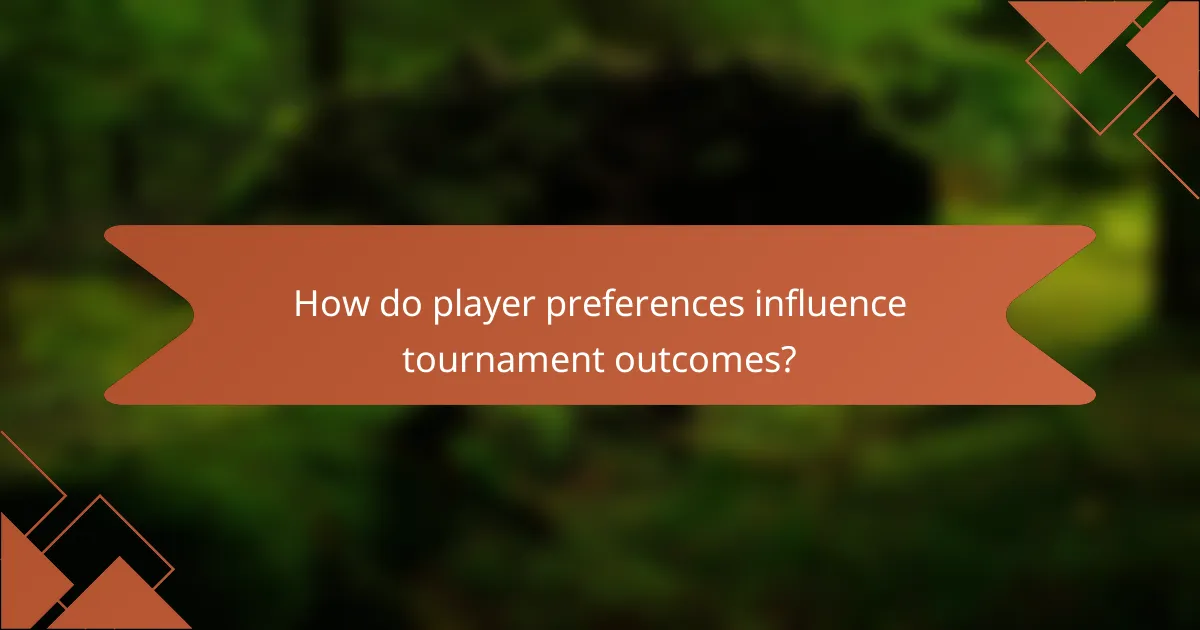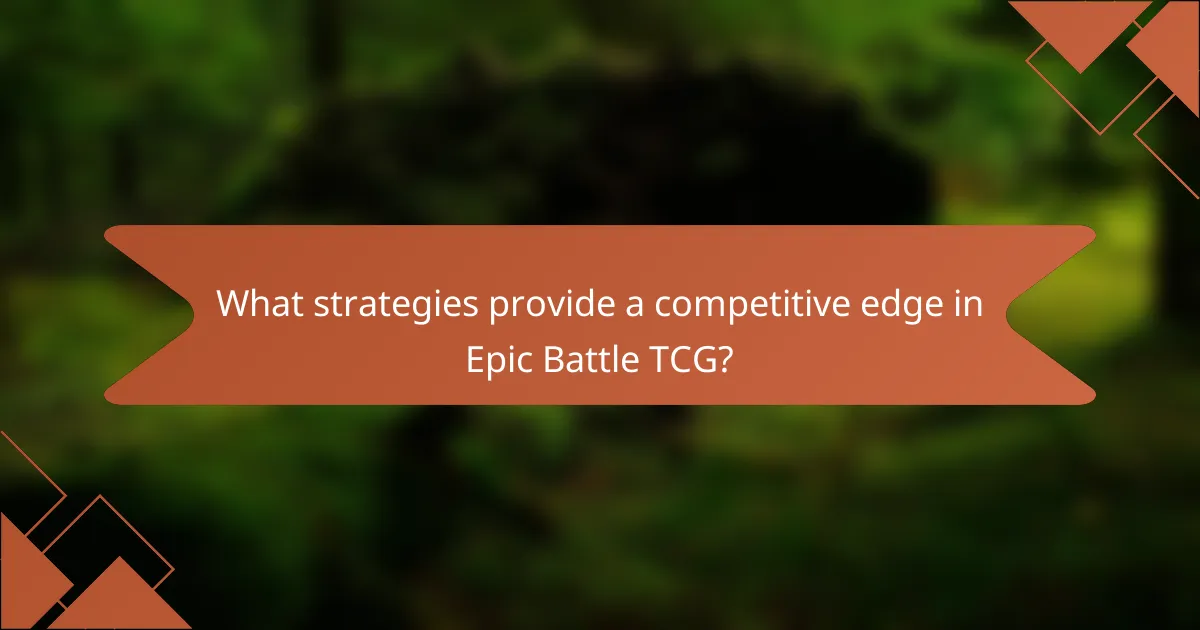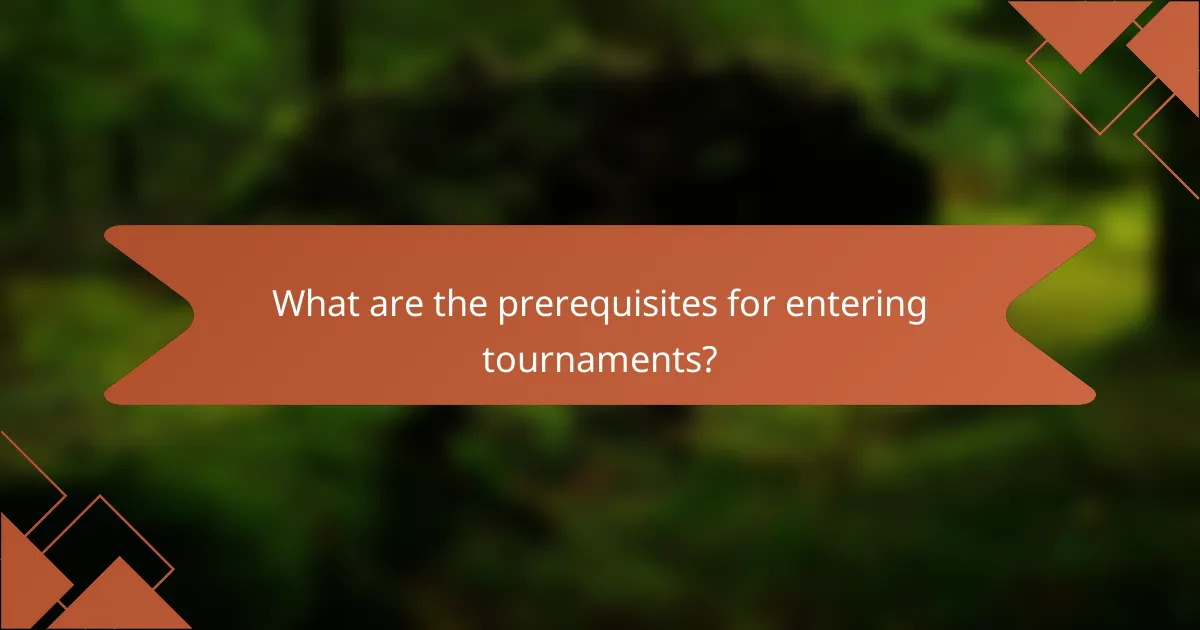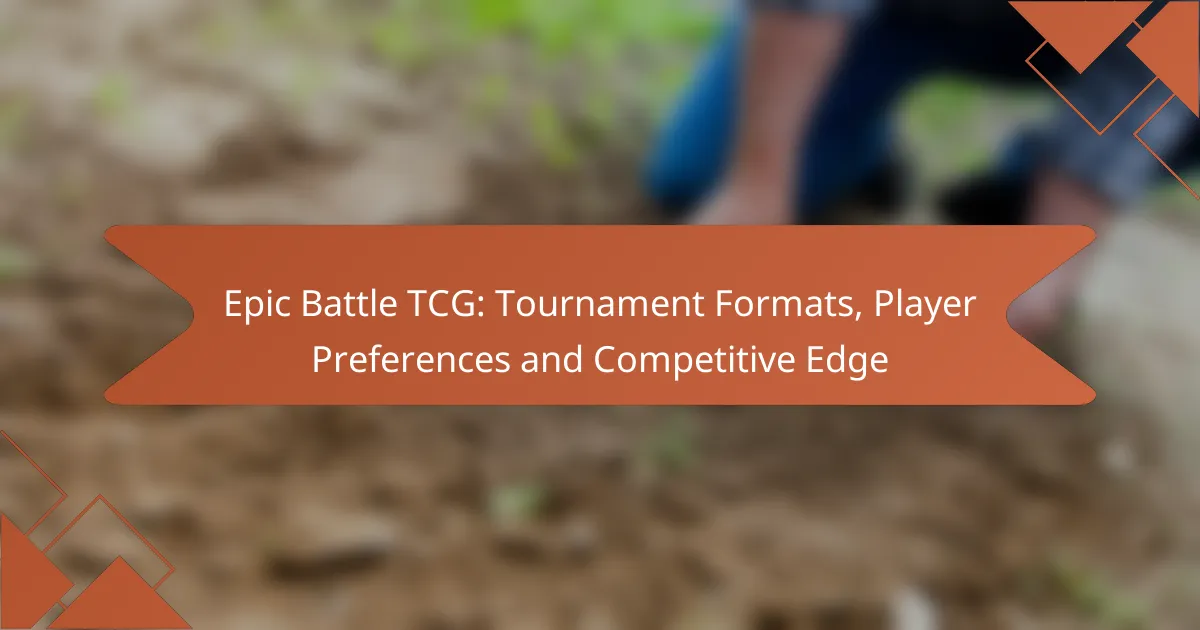Epic Battle TCG offers a variety of tournament formats that cater to diverse player preferences and skill levels, including constructed, limited, draft, sealed, and Swiss rounds. Understanding these formats and how player preferences influence deck choices and strategies is crucial for success. By focusing on card synergy, resource management, and adaptability, players can gain a competitive edge and improve their performance in tournaments.

What are the popular tournament formats in Epic Battle TCG?
Epic Battle TCG features several popular tournament formats that cater to different player preferences and skill levels. These formats include constructed, limited, draft, sealed, and Swiss rounds, each offering unique gameplay experiences and competitive dynamics.
Constructed format
In the constructed format, players build their decks ahead of time using cards from their personal collections. This allows for strategic deck-building and the opportunity to showcase individual play styles. Players typically follow specific deck-building rules, such as a minimum number of cards and restrictions on card types.
Common strategies in constructed tournaments involve optimizing card synergies and countering popular meta decks. Players should consider the current competitive landscape when selecting their cards to gain an advantage.
Limited format
The limited format restricts players to a smaller pool of cards, usually provided during the tournament. This format emphasizes creativity and adaptability, as players must build their decks from a limited selection. Limited formats often include draft and sealed variations.
Players should focus on maximizing the potential of the available cards and creating a balanced deck. Understanding card value and synergy becomes crucial in this format, as players may need to make quick decisions based on their selections.
Draft format
In the draft format, players take turns selecting cards from booster packs to build their decks. This format typically involves multiple rounds of drafting, where players must balance their choices between building a strong deck and anticipating opponents’ selections.
Effective drafting strategies include prioritizing versatile cards and keeping an eye on the cards being picked by others. Players should also be prepared to adjust their strategies based on the evolving draft environment.
Sealed format
The sealed format allows players to build decks using a predetermined number of booster packs, usually six. Players open their packs and construct a deck from the cards they receive, promoting a different skill set compared to constructed formats.
In sealed tournaments, players should focus on card synergy and mana curve while ensuring they have a balanced deck. It’s essential to evaluate the strength of individual cards and how they fit into the overall strategy.
Swiss rounds
Swiss rounds are a tournament structure where players compete in a series of matches against opponents with similar records. This format allows for a fairer competition, as players are matched based on their performance rather than being eliminated after a single loss.
During Swiss rounds, players should aim to win as many matches as possible to secure a favorable ranking. Keeping track of match results and adjusting strategies based on opponents’ decks can be beneficial for success in this format.

How do player preferences influence tournament outcomes?
Player preferences significantly impact tournament outcomes by shaping deck choices, strategies, and overall gameplay. These preferences often stem from individual play styles, experiences, and familiarity with specific cards or mechanics, which can lead to varied performance levels in competitive settings.
Deck archetypes
Deck archetypes refer to the established categories of strategies that players can choose from, such as aggro, control, or combo. Each archetype has distinct strengths and weaknesses, influencing how players approach matchups. For instance, an aggro deck may excel in fast-paced games but struggle against control decks that can mitigate early aggression.
Understanding the prevalent archetypes in a tournament can help players select a deck that aligns with their preferences and counters popular strategies. Players should consider the current meta when choosing their archetype to maximize their chances of success.
Player skill levels
Player skill levels play a crucial role in tournament outcomes, as more experienced players often have a deeper understanding of game mechanics and strategies. Skill can affect decision-making, resource management, and the ability to adapt to opponents’ plays. Newer players may struggle with complex interactions, while veterans can exploit these weaknesses.
To improve skill levels, players should engage in regular practice, study successful strategies, and participate in local tournaments. This experience can build confidence and enhance gameplay, leading to better performance in larger competitions.
Meta-game awareness
Meta-game awareness involves understanding the current trends and popular strategies within the competitive scene. Players who stay informed about the meta can make more strategic deck choices and anticipate opponents’ moves. This awareness can be the difference between victory and defeat in tightly contested matches.
To develop meta-game awareness, players should follow tournament results, engage with community discussions, and analyze deck lists from successful competitors. Keeping up with changes in the meta allows players to adapt their strategies and maintain a competitive edge in tournaments.

What strategies provide a competitive edge in Epic Battle TCG?
To gain a competitive edge in Epic Battle TCG, players should focus on card synergy, effective resource management, and adaptability to their opponents’ strategies. These elements can significantly influence the outcome of matches and enhance overall performance in tournaments.
Card synergy
Card synergy refers to the effective combination of cards that enhance each other’s abilities or create powerful interactions. Players should prioritize building decks that maximize these synergies, as they can lead to more consistent and impactful plays. For example, pairing cards that boost attack power with those that provide additional draw options can create a formidable offensive strategy.
When selecting cards, consider their interactions and how they complement your overall game plan. Avoid including cards that do not work well together, as this can dilute your strategy and reduce effectiveness. Aim for a balanced mix of offensive and defensive cards to maintain versatility.
Resource management
Effective resource management is crucial in Epic Battle TCG, as it determines how well players can execute their strategies. Players must carefully track their resources, such as energy or mana, and plan their plays accordingly to avoid running out at critical moments. A common pitfall is overcommitting to early plays, which can leave players vulnerable later in the game.
To improve resource management, consider establishing a resource curve in your deck. This means including a balanced distribution of cards with varying costs, allowing for smooth transitions from early to late game. Regularly assess your resource allocation during matches to ensure you are making the most efficient use of your available options.
Adaptability to opponents
Adapting to opponents is essential for gaining a competitive edge in Epic Battle TCG. Players should observe their opponents’ strategies and adjust their own tactics accordingly. This might involve changing your playstyle, targeting specific cards, or altering your resource allocation based on what your opponent is doing.
To enhance adaptability, practice recognizing common strategies and countering them effectively. For instance, if facing a deck focused on rapid aggression, consider prioritizing defensive cards or strategies that can stall their momentum. Being flexible and responsive can often turn the tide of a match in your favor.

What are the prerequisites for entering tournaments?
To enter tournaments for Epic Battle TCG, players must meet specific prerequisites that include registration, deck legality, and adherence to player conduct rules. Understanding these requirements ensures a smooth tournament experience and enhances competitive play.
Registration requirements
Players must register for tournaments in advance, typically through the official Epic Battle TCG website or event organizers. Registration may require a nominal fee, which can vary based on the tournament’s scale and location.
It’s essential to check the registration deadlines, as they can range from a few days to several weeks before the event. Some tournaments may allow on-site registration, but spots are often limited and may fill quickly.
Deck legality
Deck legality refers to the rules governing which cards can be used in tournament play. Players must ensure their decks comply with the current format’s legal card pool, which is updated periodically to maintain balance and fairness.
Before entering a tournament, verify that your deck includes only cards that are allowed in the specified format, such as Standard or Modern. Familiarize yourself with any banned or restricted cards to avoid disqualification.
Player conduct rules
Player conduct rules outline the expected behavior during tournaments to maintain a respectful and fair environment. Participants are expected to demonstrate good sportsmanship, follow the tournament’s code of conduct, and respect their opponents and judges.
Common conduct violations include cheating, harassment, and unsportsmanlike behavior. Familiarize yourself with the specific rules of the tournament to ensure compliance and avoid penalties, which can range from warnings to disqualification.

How do tournament structures vary by region?
Tournament structures for Epic Battle TCG differ significantly across regions, influenced by local player preferences and competitive norms. Understanding these variations can help players prepare effectively for events in different areas.
North America
In North America, tournaments often follow a Swiss format, where players compete in several rounds based on their win-loss record. This structure allows for a larger number of participants and ensures that players of all skill levels have a chance to compete against others of similar performance.
Regional championships may also incorporate a top cut, where the best-performing players advance to a single-elimination phase. This format is popular as it creates high-stakes matches that are exciting for both players and spectators.
Europe
European tournaments frequently utilize a combination of Swiss rounds followed by a cut to a top eight or top sixteen. This method balances the need for fair competition with the excitement of knockout rounds. Players often appreciate the opportunity to play multiple matches before elimination.
Additionally, some European events may have specific rules regarding deck construction and sideboarding, reflecting local preferences for strategic depth and variety. Players should familiarize themselves with these rules ahead of time to avoid disqualification.
Asia
In Asia, tournament structures can vary widely, with some regions favoring round-robin formats, especially in local events. This approach ensures that all players face each other, promoting a sense of community and engagement among participants.
Major tournaments may adopt a Swiss format similar to North America, but often with stricter time limits for each round. Players should be prepared for fast-paced matches and develop strategies that can be executed quickly to maintain a competitive edge.
Australia
Australian tournaments typically follow a Swiss format as well, with a focus on inclusivity and community building. Events often feature a mix of casual and competitive play, allowing players to enjoy the game regardless of their skill level.
In larger events, a top cut may be implemented, similar to other regions, but with a strong emphasis on sportsmanship and fair play. Players are encouraged to engage positively with their opponents and the tournament staff.
